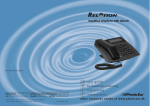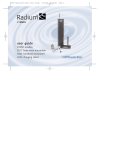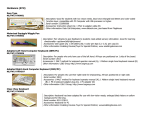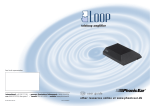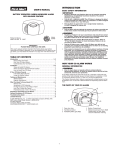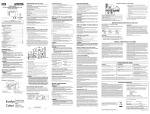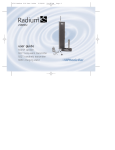Download User Manual LES 600 Series - Lightspeed Technologies, Inc.
Transcript
LES 600 Series Listening Enhancement System tm for Sound-Field Classroom Amplification User Manual 1-800-732-8999 www.lightspeed-tek.com L i g h t S P E E D Te c h n o l o g i e s , I n c . May 2002 Table of Contents Several studies validated by the U.S. Department of Education and the Educational Audiology Association verify that poor classroom acoustics, high ambient noise, and temporary mild hearing loss among children place many students academically at risk. The Sound-Field FM Classroom Amplification provided by the LES 600 increases both the volume and clarity of your voice, and evenly distributes it so that no matter where students are seated, they have equal opportunity to understand what is being said, regardless of seating arrangement. The following pages provide: Operating Instructions Microphone Placement Connecting to Other Audio Equipment Tips on Using Classroom Amplification Reference Guide to Controls Trouble Shooting Transmitter and Battery Care Pages 4 7 10 12 14 18 20 Now we hope you will enjoy using what many principals, teachers and students are calling, “One of the most effective teaching aids introduced in the decade.” 4 L E S 6 0 0 O P E R AT I N G I N S T R U C T I O N S Operating Instructions Step1 Power for Your LES 600 Receiver/Amplifier 1 Check that: • Both front panel microphone volume controls (MIC 1 VOLUME and MIC 2 VOLUME) are set to minimum (turned fully counter-clockwise). • The Receiver/Amplifier is connected to a power source: Use the enclosed AC/DC power adapter to plug into a power cord or a standard wall electrical outlet, and connect the other end to the DC POWER IN jack on the back panel. • The speakers are connected as instructed in the Installation Guide included in your packing box. Turn ON the MIC 1 VOLUME power/volume knob located on the left side of the front panel of the Receiver/Amplifier. The red POWER light on the top left should light up. (If your system has Note Refer to the the optional additional wireless modReference Guide on page 14 to identify the name and ule installed, you may turn the Mic 2 location of each component Volume power/volume knob on as of your system. well. This knob is located on the right Familiarizing yourself with side of the front panel and has its own these pages may be helpful POWER light on the top right that if you are unfamiliar with will light up.) 2 electronic equipment. L E S 6 0 0 O P E R AT I N G I N S T R U C T I O N S 5 Step2 Power for Your Belt-Pack Transmitter & Microphone 1 Ensure the Belt-pack Transmitter is turned OFF. 2 Your Belt-pack Transmitter has its internal rechargeable batteries already installed. Connect one end of the Charging Cable to one of the TRANSMITTER CHARGING jacks on the back panel of the Receiver/ Amplifier. Connect the other end of the Charging Cable to the INPUT charging jack on the side of the BP-60 Belt-pack Transmitter as shown in the illustration. 3 The battery charging indicator LED (labeled CHARGING) lights green when the Transmitter is connected with a charging cable to the TRANSMITTER CHARGING jack on the back panel of the Receiver/Amplifier. When charging is complete (8-12 hours), the CHARGING indicator light will turn off. Note The internal rechargeable batteries are not completely charged when shipped. They must be fully charged for 8 or more hours before regular classroom operation. 6 Note L E S 6 0 0 O P E R AT I N G I N S T R U C T I O N S 4 NiMH batteries will usually maintain their charge for a full day of normal classroom use. Always switch the Transmitter OFF when not in use (lunch hour, quiet times, etc.). Should the batteries in the Transmitter need to be changed, open the lower plastic cover by pressing the ribbed portions on both sides of the cover (located near the center of the Transmitter) towards each other. At the same time, pull forward on the cover, rotating it on the hinges located at the bottom of the cover. Insert the new batteries (paying attention to the + and - as indicated inside the case). Rotate the cover back toward the Transmitter center and snap it back into a locked position. 5 To attach the Microphone to the Transmitter, align the microphone plug over the belt-pack connector jack. With the black plastic dot facing forward, gently guide the connector into the jack. Be sure not to put undue stress on the wire or connector. To remove the Microphone, simply press inwards on the black plastic dot located on the microphone connector. Holding the connector rather than pulling on the wire, gently remove the connector from the Transmitter jack. 6 A switch on the top of the Transmitter case activates the Transmitter. When turned ON, the red POWER indicator will flash briefly.If the indicator remains lit continuously, the battery charge is getting too low and must be recharged. There is a delay of about one-second from the time the Transmitter switch is turned ON until the Receiver sends a signal to the Amplifier. This is normal. When the Transmitter power is turned OFF, the microphone audio to the Receiver is automatically muted. L E S 6 0 0 O P E R AT I N G I N S T R U C T I O N S 7 Step 3 Positioning Your Microphone After the microphone is connected to the belt-pack Transmitter, position the microphone as described below: 1 Lavaliere Microphone: The lavaliere microphone should be hung around the neck as illustrated, resting on your collar bone. The neck cord is adjusted by squeezing the two long ends together and then sliding the adjuster up or down the cord. 2 Flexible Collar Microphone: The flexible collar microphone is wrapped around the neck with the microphone element positioned 3-4 inches from the mouth, as shown. 3 Noise-canceling Headset Microphone: The headset micro phone is placed from behind the head over both ears. (Like putting a pair of glasses on backwards). The microphone arm is then adjusted up or down to follow along your jaw line with the microphone element at the end positioned about 3/4” from the chin as shown. The flat side (with screwhead) should be facing away from your mouth. Step 4 Adjusting Microphone Volume 1 Make sure the Receiver/ Amplifier is switched ON and the Microphone is securely connected to the Transmitter. 2 Switch the Transmitter to the ON position. The red POWER indicator on the Transmitter will flash briefly. The yellow RF INDICATOR on the front panel of the Receiver/ Amplifier should light, indicating that it is receiving the Transmitter signal and is ready for use. Note Feedback or "squealing" may occur if the volume is set too high. Reducing the loudness of the speakers with the volume control usually eliminates feedback. 8 3 L E S 6 0 0 O P E R AT I N G I N S T R U C T I O N S When speaking at a normal voice level, the green AF INDICATOR on the Receiver/Amplifier front panel should flash on and off as the voice level goes up and down. While speaking at a conversational voice level, slowly turn the MIC 1 VOLUME control knob clockwise to increase the loudness of the speakers until the sound level is adequate for the room. Step 5 Power for Your *Optional* Hand-held Microphone The Hand-held Microphone comes with a Battery Charger and three (3) NiMH rechargeable batteries. 1 Confirm that the Receiver/ Note The rechargeable batteries are not fully charged prior to delivery. In order to prolong battery life, batteries should be charged for at least 8 hours before first using. Amplifier is connected to a standard electrical wall outlet or power strip. 2 To charge the Hand-held Microphone/Transmitter, connect the Microphone/ Transmitter to the Receiver/ Amplifier as shown using a Charging Cable. The green CHARGING light on the front of the Receiver/Amplifier will come on. L E S 6 0 0 O P E R AT I N G I N S T R U C T I O N S 9 3 The batteries will fully charge in about 8-12 hours. 4 When in normal use, it is best to leave batteries on the charger until used, since there is a small amount of discharge after 48 hours. However, do not leave battery(ies) plugged into the charger for more than 5 days as it will significantly shorten your battery life. Note If the batteries are not going to be used for an extended period of time (Christmas, spring, summer break, etc.) it is important to charge the battery for at least 8 hours before removing them from the Charger and then storing them (not in the Transmitter) in a dry, mild temperature environment. 5 Once the batteries are charged, remove the Charger Cable from the Transmitter. 6 Make sure the Receiver/Amplifier is switched ON. 7 Switch the Transmitter to the “ON” position. A switch on the side of Note The Hand-held the Transmitter case activates the Microphone will best microphone. When turned ON, transmit a child’s voice the red battery condition indicator when held 1-2 inches from the mouth. will momentarily flash and a green light will glow, indicating that the Transmitter battery is good. When the red indicator remains lit continuously, the batteries are getting too low and should be changed. There is a delay of about one-second from the time the Transmitter switch is turned on, to when the Receiver will send the signal to the Amplifier. This is normal. The amber RF light on the front panel should light, indicating that it is receiving the Transmitter signal and is ready for use. 10 8 L E S 6 0 0 O P E R AT I N G I N S T R U C T I O N S When speaking at a normal voice level, the green AF indicator light (on the Receiver/Amplifier front panel) should flash on and off as the voice level goes up and down. While speaking at a normal voice level, slowly turn the MIC 1 VOLUME or MIC 2 VOLUME (if applicable) control on the LES 600 clockwise to increase the loudness of the speaker(s) until the sound level is adequate for the room. Connecting to Other Audio Equipment CD or Cassette Player, VCR or TV Note The AUX1 INPUT and AUX2 INPUT jacks are monaural. If a stereo source like a CD, VCR or tape player is used, a common stereo-to-mono adapter is necessary to convert the stereo signal to mono for input to the LES 600. Connect a line-level output from the audio source to the AUX 1 INPUT or AUX 2 INPUT on the back of the Receiver/Amplifier using an RCA-type male connector. With the Receiver/Amplifier turned on, and the MIC 1 VOLUME or MIC 2 VOLUME switch turned on, slowly increase the appropriate AUX 1 VOLUME or AUX 2 VOLUME on the front of the Receiver/ Amplifier. Increase the level until audio from the audio source is heard through the speaker. Assistive Listening Devices (ALD) Select MIXED AUDIO OUTPUT 1 or OUTPUT 2 on the back of the Receiver/Amplifier. Turn the selected Mixed Audio Output LEVEL ADJUST fully counter-clockwise. Connect the Mixed Audio Output of the Receiver/ Amplifier with a cable having a RCA connector at one end. Connect the other end of that cable to the ALD transmitter using a connector that will properly fit. Different manufacturers use different audio input jacks to their Transmitters. For example, PhonicEar L E S 6 0 0 O P E R AT I N G I N S T R U C T I O N S and Telex transmitters use 2.5mm and 3.5mm audio input jacks, respectively. With the Receiver/Amplifier turned ON, increase the Mixed Audio Output LEVEL ADJUST slowly clockwise until you reach a comfortable volume. 11 Note If you have any questions regarding the connection of assistive listening devices contact LightSPEED for technical assistance at 1-800-732-8999. Connecting to A LightSPEED CX-50 Receiver A 1/4” phone-to-RCA cable is used. The 1/4” phone plug goes into the AF OUT jack on the back of the CX-50. The RCA plug is inserted into AUXILIARY INPUT jack on the Receiver/ Amplifier. For the best sound quality, the volume adjustment on the front of the CX-50 should be turned clockwise as far as it will go. Depending on which AUX INPUT jack is selected, the audio output is adjusted using AUX1 or AUX2 VOLUME controls on the front of the Receiver/Amplifier. 12 L E S 6 0 0 O P E R AT I N G I N S T R U C T I O N S Tips on Using Classroom Amplification These helpful suggestions are provided to maximize the successful use of your new Classroom Amplification system: • Involve your students in this new process right from the beginning. When setting the volume, ask the students, “What is the correct volume?” (Each level will seem “louder” for them than you.) Ask, “When should we use the hand-held microphone?” Some teachers introduce the system by passing the hand-held microphone around the room for each student to say hello. • With the Lavaliere and Flexible Collar Microphone, position the microphone so that it is 4-5 inches from your mouth. This allows a good signal to be picked up yet is far enough from the mouth to minimize extraneous noises generated during speech. Keep the foam cover on the microphone to help reduce additional noise. • Speak in a natural voice. A normal conversational speech level should provide an adequate speech signal. It is not necessary to increase the intensity of your voice because the FM system is providing adequate amplification (approximately 5-10 dB) above your normal voice level. • Avoid wearing jewelry that may rub or knock against the microphone or mic cord and produce unwanted noise. • Find a safe, secure place away from excessive heat, cold or dampness for overnight storage of the Transmitter and Hand-held Microphone. Do not wrap the cord around the Transmitter. • Use the on/off control on the Transmitter to mute the system when needed (such as during private conversations with a student, parent, or other classroom visitor). Since this equipment is sometimes capable of transmitting more than 100 feet, private conversations in the hallway, in the staff room or on the playground may also be broadcast to the class if the Transmitter is not turned off! L E S 6 0 0 O P E R AT I N G I N S T R U C T I O N S 13 • Turn the body-pack Transmitter and/or the Hand-held Microphone OFF whenever leaving the classroom. • Recharge batteries each night. Operating time (actual usage) for the Transmitter when using the rechargeable batteries should be more than adequate for a typical school day. Your rechargeable batteries should last for a normal school year if properly cared for. • Do not recharge disposable batteries as they can overheat and explode, creating a significant hazard. This may also damage the Battery Charger or Transmitter, voiding the warranty. • Try to avoid bumping or dropping the Microphone and/or Transmitter. Treat cords (particularly near the attachments), microphones, and batteries gently. These are usually the areas that tend to malfunction first from misuse. • Avoid winding the Microphone cable around the body-pack Transmitter. This can damage or break the connecting cord, producing static or noise in the FM system. • Avoid blowing into the microphone when testing it. Instead, rub fingers over the foam microphone cover, or snap fingers near the microphone. Or conduct a consonant test by saying “ah, bah, s, sh, th”, etc. These consonant sounds represent some of the softer frequency ranges of speech and if they can be heard and distinguished, your equipment is working effectively. • The Receiver/Amplifier has two auxiliary sound source input jacks that may be used to amplify additional complimentary audio from a VCR, CD-ROM, computer, cassette tape player, etc., with a simple connecting cable (not included). For any difficulty or questions not addressed here, please contact LightSPEED’s Service Department at 1-800-732-8999, 7:00am - 5:00pm PST. 14 L E S 6 0 0 O P E R AT I N G I N S T R U C T I O N S Reference Guide to Controls Power Power RF RF 5 1 2 6 AF Aux1 Volume AF 7 3 8 Mic1 Volume Aux2 Volume Mic2 Volume 9 4 10 11 Charging 12 LES-600 T e c h n o l o g i e s 1 & 5 Power Indicator: When power is switched on, the red POWER light will come on. 2 & 6 Radio Frequency Indicator: The RF Indicator displays that the LES 600 is receiving a radio signal from the instructor’s body-pack Transmitter (or Handheld Microphone). When the Transmitter is turned ON the amber RF Indicator will light up. 3 & 7 Audio Frequency Indicator: The AF Indicator displays that the voice of the instructor is active and at an adequate level. When the Transmitter is turned on, the green AF indicator will flash on and off as the instructor’s voice is detected. L E S 6 0 0 O P E R AT I N G I N S T R U C T I O N S 15 4 & 9 Power and Volume Switch for Microphones: Rotating the Mic 1 Volume control or Mic 2 Volume control clockwise past the first “click” turns the LES 600 on. Continuing to rotate this knob clockwise will increase the volume of the wireless microphone through the speaker system. 8 & 10 Aux1 and Aux2 Volume Control: Rotating the Auxiliary Volume Control clockwise increases the loudness of an audio source connected to the AUXILIARY INPUT jack (located on the back panel). 11 &12 Battery Charging Indicator These indicators light when a Transmitter is connected to one of the TRANSMITTER CHARGING jacks (located on the back of the Receiver/Amplifier, labeled 14 & 15 on the following diagram). When charging is complete the indicator turns off. Note The LES 600 comes standard with a single wireless receiver that is controlled using MIC1 VOLUME. If an optional second wireless receiver is installed, the second receiver is controlled using MIC2 VOLUME. 16 L E S 6 0 0 O P E R AT I N G I N S T R U C T I O N S 23 EQ Q Hi 22 21 24 Mid Mic 2 Antenna Mic 1 Antenna Low w 20 19 Aux 1 Input Aux 2 Input 25 18 17 16 15 Output 1 Mi Mixed Audio u Level Adjust Speaker Zone Switch Output 2 1 26 2 27 3 28 Level Adjust F1 14 Speaker Ouputs Transmitter Charging F2 F3 13 4 DC Power In 29 30 13 DC Power Connector: The Receiver/Amplifier requires a 15-volt, 2.4 Amp DC power supply. The center conductor is positive (+) polarity. Caution: Power supplies from different manufacturers have various output voltages, current ratings, and polarity. Connecting the wrong type of power supply can result in damage to the LES 600. 14 & 15 Transmitter Charging Jacks: This is used to charge the rechargeable NiMH batteries in the belt-pack Transmitter and optional Hand-held Microphone. One end of the charging cable is connected to this jack. The other end of the charging cable is connected to the BATTERY CHARGING INPUT located on the side of the belt-pack Transmitter, or bottom of the Hand-held Microphone. See previous diagrams on page 5 and 8. 16 & 18 Mixed Audio Output Level Adjust: Rotating the MIXED AUDIO OUTPUT ADJUST clockwise increases the level of the audio signal at the Mixed Audio Output jack located on the back panel. 17 & 19 Mixed Audio Output Jack: The Mixed Audio Output jack sends to an external source, the same audio information that is being supplied to the speaker system. For example, this output could be used to connect to a tape recorder for recording purposes, or to an assistive listening device such as LightSPEED’s LES-360 FM Personal Listening System. L E S 6 0 0 O P E R AT I N G I N S T R U C T I O N S 17 20 & 21 Aux1 and Aux2 Input Jacks: The AUXILIARY INPUT jack is used to connect to an external audio source (for example, a CD or tape player to add background music) to mix with your voice audio from the wireless microphone. AUX1 level is adjusted by using the AUX1 VOLUME on the front; AUX2 is adjusted by AUX2 VOLUME. 22 & 24 Antenna Connector: The chrome antenna is connected to the Antenna Connector on back of the Receiver/Amplifier. The antenna should be kept vertical for best reception. MIC2 ANTENNA is used if an optional second wireless receiver is installed. 23 EQ Adjusters: The three Frequency Equalization Adjustments are factory set for a normal classroom environment. These EQ adjusters function similar to the “bass” and “treble” on your home stereo. A combination of small adjustments to these knobs will help clarify your amplified voice tones for better student hearing and comprehension. Adjustments to the high, medium, or low frequencies can assist with the removal of “squeal” or feedback. 25 Serial Numbers and Frequency: These labels inform you of your system’s serial numbers and wireless frequency. You will need this information any time you call LightSPEED’s Service Department. 26-29 Speaker Output Connectors: These connectors are used to attach the wires from the loudspeaker system to the Receiver/Amplifier. Each connector pair has its own switch to allow for speaker zones. 30 Speaker Filters: These filters (labeled LF, MF and HF) are preset at the factory for optimum performance. If you have questions or concerns about these filters or their settings, please call LightSPEED or see your speaker installation instructions. 18 L E S 6 0 0 O P E R AT I N G I N S T R U C T I O N S Trouble Shooting Guide Please go through this checklist before calling LightSPEED Technologies Service Department. Battery Check • Transmitters are charged via a jumper cable from the back of the Amplifier. Make sure plugs are secured, and in the proper jacks. • Confirm the CHARGING light located on the front panel of the amplifier is on while charging. Note Most problems associated with wireless FM systems are directly related to low battery power. The first thing to check is the batteries. • Be sure Transmitter is turned OFF while charging. • The batteries used in the Hand-held microphone are also charged from the Transmitter Charging jack on the back of the Receiver/Amplifier. Hearing Static • Test Transmitter with fully charged batteries. Regular alkaline batteries may be used for testing purposes. • Confirm the plug on the microphone cable is firmly seated into the Transmitter jack. • If you have access to another mic, try it in your Transmitter. If it works, your original mic may need to be replaced. If the system checks out okay, and you still hear some occasional static or popping, you may be experiencing radio frequency interference (RFI). If the mic is okay, and you think it may be interference, confirm that your frequency is not being duplicated by another wireless FM system within the building. Continued RFI may require exchanging your system for one with a different frequency. • Keep Receiver/Amplifier at least 6 ft. away from computers. L E S 6 0 0 O P E R AT I N G I N S T R U C T I O N S 19 Low Volume • Check volume level on Receiver and adjust as necessary. • If volume is too low, check the “MT” adjustment inside the battery compartment of the belt-pack Transmitter. Clockwise adjustment of the “MT pot” will increase volume. Sound Fades In and Out (Drop Out) • Confirm Amplifier antenna is securely attached and visible from all areas of the room where the Transmitter is operating. • Test transmitter with fully charged batteries. You can use any known, good quality batteries for testing. No Sound From Speaker • Confirm the Transmitter and Receiver have matching frequencies. Check both MIC 1 VOLUME and MIC 2 VOLUME. If system is equipped with optional Mic 2 Receiver, look for second antenna on back of Receiver/Amplifier. • Confirm the plug on the microphone cable is securely fitted into the Transmitter microphone jack. • Confirm Amplifier power supply is the correct type, is connected securely in the wall outlet and into the back of the Receiver/Amplifier. • Turn on Receiver/Amplifier; confirm that the POWER light located on the front panel is on. • Check volume. • Turn on Transmitter and confirm amber RF light, located on the front panel of the Receiver/Amplifier, flashes when speaking into the microphone. • Confirm batteries in the Transmitter are good. The red battery indicator light should flash once as you turn on the Transmitter. The same holds true with the hand-held microphone. If the red light stays on, your batteries are low. 20 • L E S 6 0 0 O P E R AT I N G I N S T R U C T I O N S Check to confirm speaker wires are in the correct wire terminals on the back of the Receiver/Amplifier and confirm that the speaker switch for that speaker output is in the ON position. Black (or black stripe) to black terminal. White or gray wire to red terminal. Transmitter Care • Cleaning the microphone jack and battery contacts will help ensure that your system gives you years of reliable service. We recommend using “deoxidizer” or contact cleaner every 2 or 3 months. Battery Maintenance & Care • Battery should fit snugly against the contact points inside the battery compartment. • Batteries are to be charged each night and over the weekends. They should not be left charging over the summer or during Christmas and Spring Breaks. Prior to extended breaks, systems should be fully charged and batteries removed from Transmitters. After extended breaks, reinstall batteries and recharge batteries before using again. • Battery removal in the Handheld Transmitter is achieved by sliding down the battery cover and lifting the black “ribbon” to pop the first battery out. Then pull the white plastic battery guide towards the bottom of the Transmitter while guiding the remaining two batteries out of the battery compartment. Slide the white guide back into the Transmitter to install batteries. If you have gone through this checklist and are still having problems, write down the serial numbers and frequency of your system. Call LightSPEED Service Department at 1-800-732-8999 7:00am – 5:00pm PST L E S 6 0 0 O P E R AT I N G I N S T R U C T I O N S 21 FCC Notice This device complies with part 15 of the FCC Rules. Operation is subject to the following two conditions: (1) This device may not cause harmful interference, and (2) this device must accept any interference received, including interference that may cause undesired operation. Changes or modifications not expressly approved by the party responsible for compliance could void the user’s authority to operate this equipment. This equipment has been tested and found to comply with the limits of a Class B Digital Device, pursuant to Part 15 of the FCC Rules. These limits are designed to provide reasonable protection against harmful interference in a residential installation. This equipment generates, uses and can radiate radio frequency energy and, if not installed and used in accordance with the instruction may cause harmful interference to radio communication. However, there is no guarantee that interference will not occur in a particular installation. If this equipment does cause harmful interference to radio or television reception, which can be determined by running the equipment off and on, the user is encouraged to try to correct the interference by one or more of the following measures: • Reorient or relocate the receiving antenna. • Increase the separation between the equipment and receiver. • Connect the equipment into an outlet on a circuit different from that to which the receiver is connected. • Consult LightSPEED for help (1-800-732-8999). 22 L E S 6 0 0 O P E R AT I N G I N S T R U C T I O N S Warranty Five Year Limited Warranty to Original Purchaser LightSPEED 600-series Classroom Amplification Systems are guaranteed against malfunction due to defects in materials and workmanship for a period of five years, beginning at the date of the purchase invoice. If such malfunction occurs, the product will be repaired or replaced (at LightSPEED’s option) without charge during the period and under the limitations stipulated in the data sheet or this users manual. Limited exclusions specifically apply to microphone elements, rechargeable batteries, battery chargers and their assemblies, also external cables and wires. Warranty on microphones/microphone elements is limited to the original manufacturer’s warranty (usually 1 year). If delivered prepaid to the LightSPEED factory or an authorized warranty service center, the unit will be returned prepaid. Warranty does not extend to finish, appearance items, or malfunctions due to abuse or operation other than specified conditions, nor does it extend to incidental or consequential damages. Repair by other than LightSPEED or its authorized service agencies will void this guarantee. Information on authorized service agencies is available from LightSPEED Technologies, Inc. Extended warranties are available for most products. Please contact LightSPEED for further information.





















